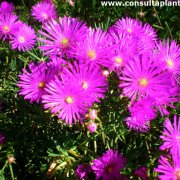Care of the succulent plant Lampranthus multiradiatus or Red vygie |
|
The genus Lampranthus, family Aizoaceae, comprises 250 species of succulent plants native to southern Africa. Some species are: Lampranthus multiradiatus, Lampranthus zeyheri, Lampranthus falcatus, Lampranthus blandus, Lampranthus aureus, Lampranthus amoenus, Lampranthus spectabilis. Common names: Oxenbould daisy, Many-petalled Lampranthus, Red vygie, Rosy Dew Plant, Mini Ice Plant. Scientific synonyms: Mesembryanthemum multiradiatus, Lampranthus roseus. This species is native to South Africa. They are evergreen succulent plants with a shrubby habit that reach 60 cm (23.6") in height. The triangular, fleshy and slightly curved leaves are grayish-green in color. The attractive, bright 4 cm (1.75") diameter flowers can be purple, cream, orange, pink, lilac, white or red. They bloom from late spring to early summer. Red vygie is used in rockeries, on slopes, in groups in dry areas of the garden and in pots for terraces and balconies. It's ideal plants for Mediterranean coastal gardens. Lampranthus multiradiatus needs full sun exposure and high temperatures. It resists occasional frosts down to -5 ºC (23 ºF). Mini Ice Plant grow in any type of soil that drains well: sandy, calcareous and poor. Planting or transplanting is done in spring. Water moderately all year long, waiting for the substrate to dry well; they are very resistant to drought. Fertilize with compost in late winter. Oxenbould daisy does not need pruning but faded flowers can be removed. Lampranthus multiradiatus is a plant resistant to pests and diseases that does not resist excess humidity. Rosy Dew Plant propagates from seeds sown in mid-winter or by cuttings in early fall. |
Images of the succulent plant Lampranthus multiradiatus or Red vygie |
Find plants
Lampranthus multiradiatus or Red vygie | Care and Growing
© 2026 FavThemes



